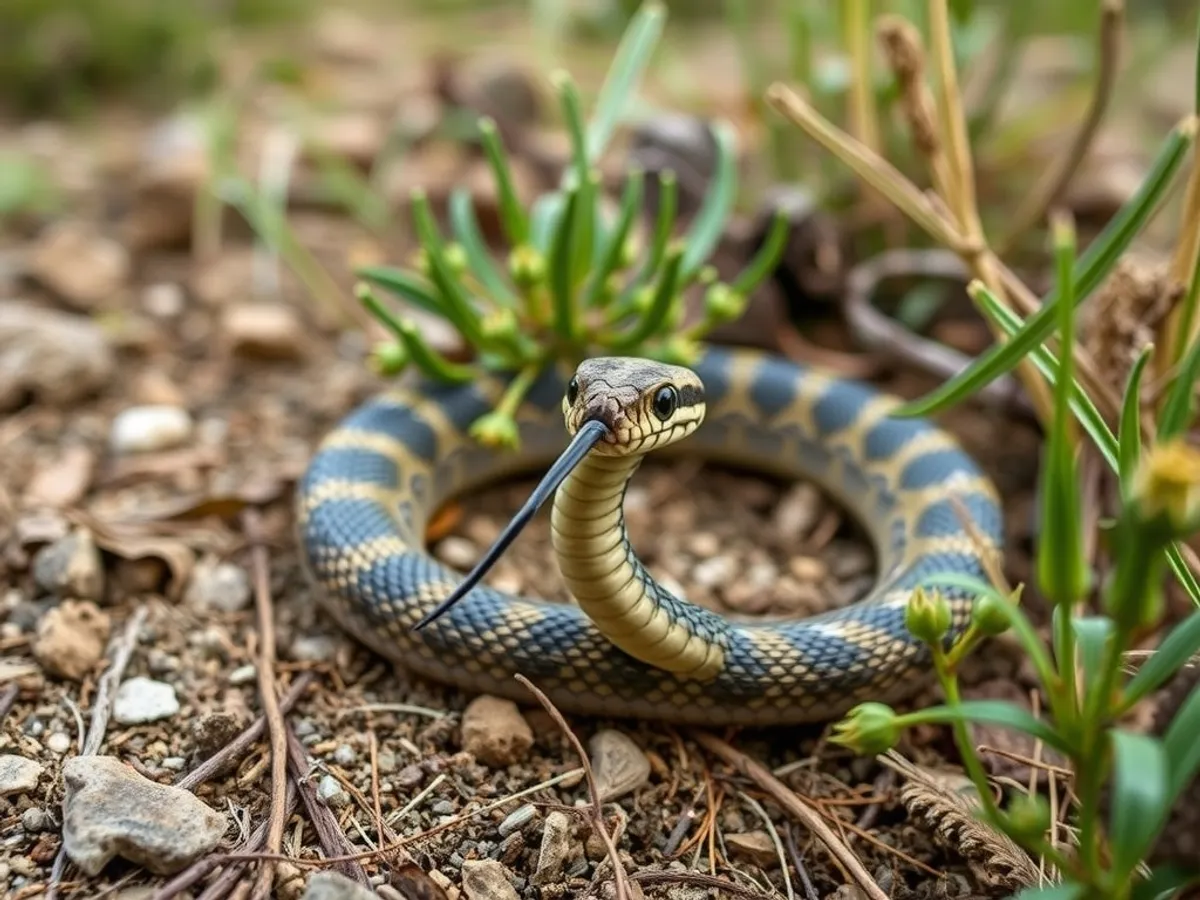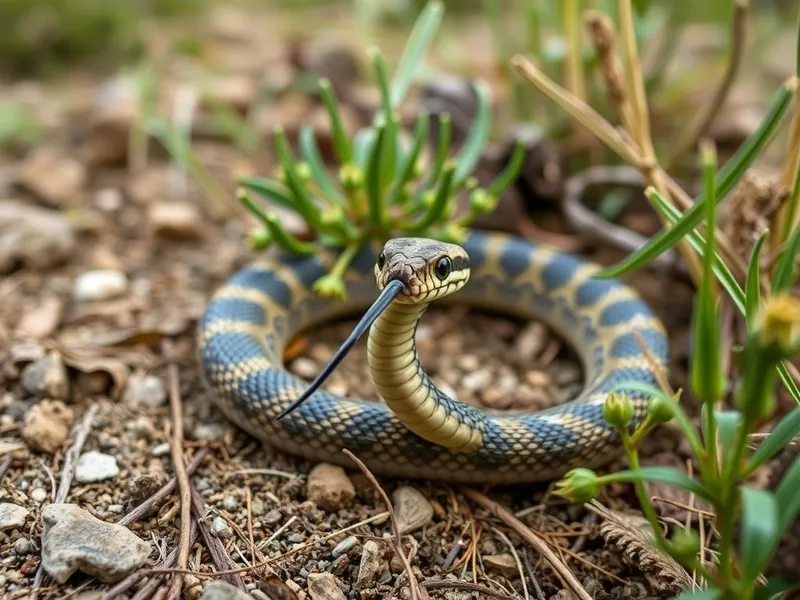
Long-nosed Snake
Rhinocheilus lecontei

Meet the Long-nosed Snake
The Long-nosed Snake is a slender, nonvenomous colubrid native to the southwestern United States and northern Mexico. It is recognized by its distinctive elongated snout and striking coloration, featuring black, red, and yellow or cream bands and spots. This secretive, burrowing snake is primarily nocturnal and spends much of its time underground, emerging at night to hunt prey. While it may resemble some venomous species, it is harmless to humans and plays an important role in controlling small vertebrate populations.
Classification
Reptile
Habitat
Deserts, grasslands, and shrublands
Diet
Carnivore
Lifespan
10-20 years
Conservation
Least Concern
Weight
100-200 grams
📖Fascinating Facts
Desert Dweller
Long-nosed Snakes are well adapted to arid environments and are commonly found in deserts and dry grasslands.
Nocturnal Hunter
They are primarily active at night, hunting for lizards, amphibians, and small rodents.
Colorful Mimic
Their banded coloration mimics the appearance of venomous coral snakes, warding off potential predators.
📋Detailed Description
The Long-nosed Snake (Rhinocheilus lecontei) is a slender, medium-sized colubrid, typically reaching adult lengths of 45–90 cm (18–35 in), with some individuals exceeding 100 cm. Its most distinctive feature is the elongated, slightly upturned snout, an adaptation for burrowing in loose soils. The dorsal coloration consists of alternating black bands interspersed with red, orange, or cream-colored blotches, set against a pale yellow or cream background; the ventral surface is usually white with scattered black spots. Scales are smooth, giving the snake a glossy appearance. The head is narrow and not distinct from the neck, with round pupils and a generally docile demeanor. The Long-nosed Snake is primarily nocturnal and fossorial, spending daylight hours concealed beneath rocks, logs, or within burrows. It is a secretive species, rarely encountered above ground except during warm, humid nights or following rainfall. When threatened, it may release a foul-smelling musk and occasionally bleed from the cloaca as a defensive display. This species is nonvenomous and harmless to humans, playing an important ecological role as both predator and prey within arid and semi-arid ecosystems.
💡 Did you know?
Despite their vivid, alarming appearance, Long-nosed Snakes are completely nonvenomous and pose no danger to humans.
🔬Research & Sources
Wikipedia Summary
The long-nosed snake is a species of nonvenomous snake in the family Colubridae. The species is endemic to North America. It has two recognized subspecies. The other species in the genus were previously considered subspecies.
Last Modified: 6/10/2025
🎭Behavior & Social Structure
Long-nosed Snakes are solitary and highly secretive, exhibiting strong fossorial behavior. They emerge at night to forage, primarily during the warmer months (April–October). Their diet consists mainly of lizards (especially whiptails and skinks), amphibians, and occasionally small rodents and reptile eggs. Prey is subdued by rapid strikes and swallowed alive, as the species lacks constricting ability. Hunting is primarily by active searching, using chemosensory cues to locate prey beneath the substrate. These snakes are generally non-aggressive and rarely bite when handled, preferring to flee or employ defensive behaviors such as cloacal bleeding and musking. They are not known to form social groups outside of brief mating encounters. Activity is strongly influenced by temperature and humidity, with peak surface activity occurring on warm, moist nights.
👶Reproduction & Life Cycle
Rhinocheilus lecontei is oviparous, with breeding typically occurring in late spring to early summer (April–June). Males actively search for females, sometimes traveling considerable distances. Courtship involves tactile stimulation, with males aligning their bodies alongside females. Females lay clutches of 4–12 elongated, leathery eggs in loose soil, under rocks, or within abandoned burrows, usually in early to mid-summer. Incubation lasts approximately 50–70 days, depending on environmental conditions, with hatchlings emerging in late summer (July–September). There is no parental care post-oviposition; hatchlings are independent from birth and measure about 20–25 cm (8–10 in) in length. Sexual maturity is typically reached at 2–3 years of age.
🛡️Adaptations & Survival
The Long-nosed Snake exhibits several adaptations for a fossorial lifestyle, including a pointed, upturned snout for efficient burrowing and smooth, glossy scales that reduce friction against the substrate. Its cryptic coloration provides camouflage among leaf litter and rocky soils, while the aposematic mimicry of coral snake coloration may deter potential predators. The ability to produce cloacal musk and exude blood from the cloaca is a unique defensive adaptation, likely to startle or repel predators. Nocturnal activity reduces exposure to extreme daytime temperatures and diurnal predators. Its broad diet and ability to exploit various arid habitats contribute to its ecological success.
📚Research Sources
🎨Cultural Significance
The Long-nosed Snake is occasionally referenced in regional folklore, often mistaken for venomous coral snakes due to its similar coloration, which has contributed to its persecution by humans. However, it has no significant role in indigenous mythology or traditional medicine. Its striking appearance makes it of interest to naturalists and herpetoculturists, though it is rarely kept in captivity due to its specialized habitat needs and secretive nature.
🔬Recent Research & Discoveries
Recent genetic studies have clarified the taxonomy of Rhinocheilus, elevating former subspecies to full species status and refining the understanding of its evolutionary relationships within Colubridae. Ongoing research focuses on its ecological role in arid ecosystems, particularly its impact on lizard and amphibian populations. Studies of its defensive behaviors, including cloacal bleeding, have provided insights into anti-predator adaptations among North American snakes. There is growing interest in the effects of habitat fragmentation and climate change on its distribution and genetic diversity.
🎥Wildlife Videos

Exploring the Fascinating Vietnamese Long-Nosed Snake | Wildlife Documentary
Join us on a captivating journey into the world of the Vietnamese Long-Nosed Snake! Discover the unique characteristics, habitat, ...
Wild life Explore

Wildlife - Just Reptiles | Free Documentary Nature
Wildlife - Episode 3: Just Reptiles | Wildlife Documentary Watch 'Wildlife - Episode 4' here: https://youtu.be/SNRyvGzDsww ...
Free Documentary - Nature

The Snake That Outsmarts Nature's Best Noses | BBC Earth
A deadly predator leaves no trace – not even a scent. How does the puff adder become invisible to even the sharpest noses in the ...
BBC Earth

Extreme Snakes | Africa | Full episode | Animal documentary
Discover how the snakes of Africa evolved of millions of years. Explore diverse ecosystems, witness the behavior of magnificent ...
WildNature HDTv

Search of the Mysterious Lizard Predator: The Long-Nosed Snake - Dinosaur WILD
Within the landscape of the hot and dry Arizona desert is a seldom seen creature lurching underground. A creature that remains ...
Dinosaur WILD

Forest of the Golden Monkey (Full Episode) | The Hidden Kingdoms of China
Meet China's most affectionate and vocal monkeys in the remote, seasonal forests of Central China. Follow the journey of a baby ...
National Geographic
🌍Habitat Information
The Long-nosed Snake typically inhabits Deserts, grasslands, and shrublands environments. Long-nosed Snakes have adapted to their environments with specialized features and behaviors.
Primary Habitat:
Deserts, grasslands, and shrublands
More detailed habitat information will be available soon.
🛡️Conservation Status
The Long-nosed Snake is currently classified as Least Concern. Conservation efforts are crucial for preserving this species for future generations.
Common Threats:
- 🏠Habitat loss and fragmentation
- 🌡️Climate change impacts
- 🎯Hunting and poaching
- 🏭Human-wildlife conflict
⚠️Threats & Conservation Challenges
Currently assessed as Least Concern by the IUCN, the Long-nosed Snake faces localized threats from habitat loss due to urbanization, agriculture, and road mortality. Pesticide use and habitat fragmentation may impact prey availability and population connectivity. Despite these pressures, the species maintains stable populations across much of its range, owing to its adaptability and secretive habits. Climate change poses a potential long-term threat by altering precipitation patterns and habitat suitability in arid regions. Collection for the pet trade is minimal and not considered a significant threat.
🔬Scientific Classification
Scientific Name
Rhinocheilus lecontei
Classification Hierarchy
🔍 About Taxonomic Classification
Taxonomic classification is a hierarchical system used by scientists to classify and organize living organisms based on shared characteristics and evolutionary relationships.
The system moves from broad categories (Kingdom) to increasingly specific ones, with each animal's scientific name typically consisting of its Genus and species.
📝Community Notes
Share your observations and insights about the Long-nosed Snake with our community of wildlife enthusiasts.
Join Our Community
Sign in to share your observations and connect with fellow wildlife enthusiasts.
Sign In to ContributeNo community notes yet
Be the first to share your observations about the Long-nosed Snake!
Explore Long-nosed Snake
Select a tab above to learn more about this amazing animal.
📸Photo Gallery
No photos available for this animal yet.
🌟Discover More Wildlife
Continue your journey of discovery with more fascinating animals from our database
